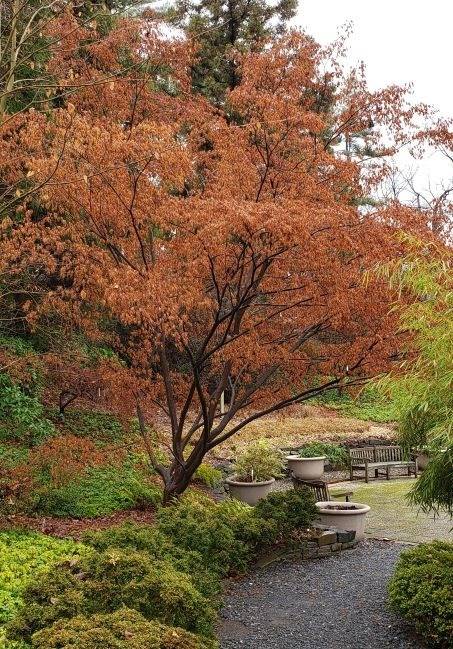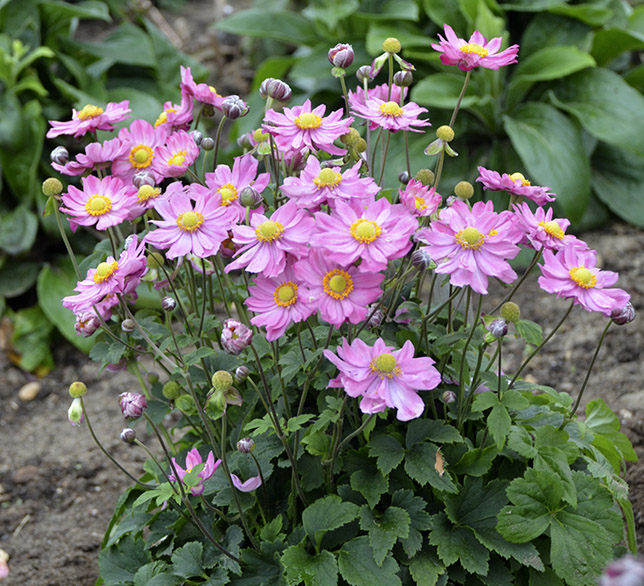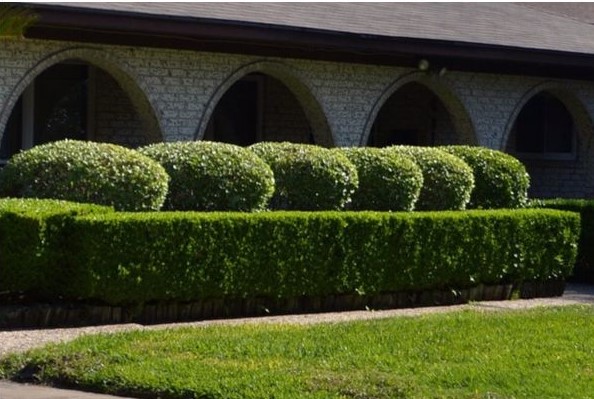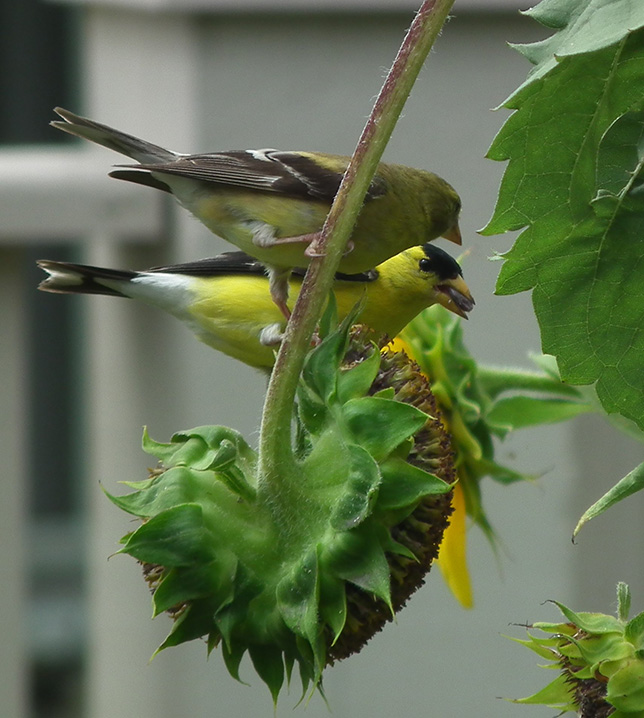January is garden planning time for most of us--a time to delve into those seed and plant catalogs that keep arriving and see what's new and exciting for the coming year. After all, the garden is sleeping and often less than inspiring on these cold, dreary winter days. If that's the case for you, perhaps perking up your winter garden might invigorate your spirit as well. No matter the time of year, a colorful and captivating landscape can be yours with the right mix of plants and accessories.

Ornamental Plants for Winter Interest
Your garden doesn’t have to spend the colder months dull and dreary. If your winter view is lacking a little magic, then add some sparkle with plants that shine when the temperatures take a dive.
Winter Garden Bloomers:
- Hellebore: Zones 3-9. Tough evergreen perennial best sited in partial shade--deep shade will reduce blooming and it prefers some relief from direct sun in the summer. Planting near or under deciduous shrubs is effective, or where it will be shaded by taller growing perennials later in the season. Blooms in shades of yellow, pale green, pale pink to deep red, smoky purple to black, and white—many with speckles, spots, or picotee edge, singles or doubles, in winter or early spring depending on your location. Large lobed leaves are leathery and dark green, often with subtle variegation. Look for newer varieties that hold the flowers outfacing for a better display. Long-lived, few pests or disease, but will sulk after root disturbance—plant it and leave it alone! Bonus of excellent deer resistance. Truly a jewel in the winter garden. Several commonly found species include: Helleborus niger (Christmas rose): earliest to bloom. Helleborus foetidus (Stinking hellebore): don't let the name scare you - the strong odor is only released when leaves are crushed. Blooming starts in January or February. Helleborus x hybrida (Lenten Rose): Usually bloom February into April.
- Pieris japonica (Andromeda): Zones 4-8. Interesting buds and colorful evergreen foliage make this shrub deserving of a place in the winter garden. Also commonly but incorrectly called "Japonica" (which means only "from Japan"), this lovely evergreen shrub prefers sun to part shade, acidic soil, and excellent drainage (similar to rhododendrons and azaleas). Covered in decorative long, tassel-like buds during winter that resemble strings of small beads, blooming in very early spring with drooping clusters of flowers resembling lily of the valley, in white, pink, or red. New foliage is usually bronze to red. Variegated ('Flaming Silver') and dwarf varieties ('Cavatine') available; 'Little Heath' is both. 'InterStella' Pieris from Proven Winners boasts ruby-red blooms and early bloom with long-lasting flowers. 'Katsura' and 'Valley Rose' have pink flowers.
- Camellia (Zones (6)7-9): Refined evergreen shrub that blooms either autumn/early winter (C. sasanqua) or late winter/spring (C. japonica). Best sited in morning sun or light shade and protected from strong winds. Prefers acidic soil and excellent drainage. Single or double flowers in white to pink to red. Showstopping in full bloom. Cold hardiest varieties go only to zone 6 without protection. Ackerman hybrids, or Winter Camellias, are interspecies hybrids most often with C. oleifera (tea-oil camellia) parentage which lends its better cold tolerance to the resulting offspring. In the northern areas where camellias can be grown it is suggested to plant in spring to allow the plant to establish itself before the onset of cold weather, and to site in sheltered positions on the north or northwest side of buildings or other windbreaks. In more southerly regions fall planting is recommended to avoid heat stress on young plants.
- Mahonia (Zones 5-9): With spiny holly-like leaves, a shape and habit similar to tall nandina, and spires of fragrant yellow flowers, this easy care shrub is deserving of more frequent use. In addition, the spiky leaf texture confers deer resistance and the attractive frosty blue berries will feed an array of birds. Makes an excellent barrier planting, evergreen screen, foundation, or specimen plant. Usually best in part sun, although can be grown in full sun to shade, and requires well-drained soil. Many species, one of which is native to the northwest US (M. aquifolium, Oregon grape holly), while M. bealeii (leatherleaf mahonia) might best be avoided as it appears to be invasive in many areas. Best options include the interspecies hybrids, M. x media, such as 'Winter Sun,' 'Marvel,' 'Charity,' and 'Hope.' Note that M. x media is now Berberis x hortensis, and there is still debate over whether the genus Mahonia is valid as several species will hybridize with some Berberis. But the store will still call it "mahonia," at least for now!
- Violas: Best winter-flowering annual. More cold and heat resistant than pansies, and the sheer number of blooms more than makes up for smaller size of flowers. Much more likely to reseed, and the innumerable flowers do make it more tedious to deadhead. Almost any imaginable color, with face or clear colors. Sadly, deer candy.
- Other Good Winter Bloomers: Hamamelis (Witch hazel), Corylopsis spicata (Spike winterhazel), 'FullMoon’ Polyspora, Erica (heather), Daphne, Sarcococca (sweet box), Grevillea x ‘Noell’, Drimys winteri var. chiloense ‘Pewter Pillar’ (Winter's Bark), Jasminum nudiflorum (Winter Jasmine), Holboellia coriacea 'Cathedral Gem'(sausage vine), English Primrose.

Below: Wintersweet (Chimonanthus praecox) lends its pale golden flowers and delicious fragrance to the winter landscape. January in Washington, DC.

Below: Many berrying shrubs, such as this winterberry (Ilex verticillata), are shown to their best advantage after the leaves fall. January in Washington, DC.

Winter Garden Plants with Attractive Bark:
- Betula nigra (River Birch): Zones 4-9. Captivating heavily exfoliating bark in cream, tan, and cinnamon shades. Best grown as multi-stem specimen. Fast growing native, easily 2’ per year to a mature height of 40 to 70 feet. Dwarf variety ‘Little King' or 'Fox Valley’ grows to 10’. Best planted in sun to part sun and moist soil; tolerates flooding and occasional drought once established. Resistant to bronze birch borer (which most other birch species show some susceptibility toward), heat tolerant As the many surface roots make these difficult to underplant these are preferable used as single or grouped specimens in their own mulched beds, preferably with uplighting to highlight the spectacular bark at night. Non-dwarf varieties should be planted well away from the house.
- Laegerstroemia indica, fauriei or hybrids (Crape Myrtle): Zones 6-10. Breeding of Crape Myrtles has been heavy of late, resulting in many very dwarf varieties (which mostly look twiggy during winter) as well as almost black-foliaged types. For most winter impact, one of the best is still the standard white “Natchez.” When choosing a Crape, look for pictures of the winter bark if you can. You won’t see this on young plants at the nursery, but a mature Crape’s trunks can rival the beauty of the flowers.
- Cornus sericea: Red-twig or Redosier Dogwood: Zones 3-8. The sight of a mass of native C. sericea glowing in the winter sun is glorious indeed. In fact, this is their season—being rather inconspicuous the rest of the year. As such, though, they make a good backdrop for other plants, and will provide white flower clusters and showy fruit that attracts birds. Best in full to part sun and moist soil—may sucker aggressively in wetter soils. Average 6-8’ high and wide, dwarf cultivar ‘Kelseyi’ to 2.5’, and some varietes have bright yellow stems. A similar native with reported better leaf spot resistance is Cornus amomum (Silky dogwood) 'Cayenne.' This red-stemmed variety was originally found in a beaver swamp in Virginia. Unlike Red-twig Dogwood, Silky Dogwood is found throughout the southeast, so is better suited to heat and humidity than its northern cousins. Note: Non-native Cornus alba (Tatarian Dogwood) is also called Red-Twig Dogwood, and non-native Cornus sanguinea is called Blood Twig Dogwood--both have similar features as well as variegated types. This is one of those times when botanical nomenclature is essential in understanding what you are purchasing!
- Other Good Choices with Attractive Bark: Acer griseum (Paperbark Maple), Ulmus parviflora (Lacebark Elm), Acer palmatum ‘Sango Kaku’ (Coral bark Japanese Maple), Heptacodium miconiodes (Seven Son Flower), Parrotia persica (Persian Ironwood), Stewartia pseudocamellia, Stewartia sinensis, Stewartia monadelpha
Winter Garden Plants with Attractive Silhouette or Structure:
- Corylus avellana 'Contorta' (Harry Lauder’s Walking Stick): Zones 4-8. Also called corkscrew filbert, every part of this unique plant is curled and contorted--trunks, stems, and leaves. Well, with the possible exception of the roots--most nursery plants are grafted to a different (non-contorted) rootstock, so any suckers must be pruned out to retain the interesting structure. Plant in full sun to part shade in well-draining soil. Grows in a rounded shape 8 to 10' high and wide. Especially nice where the winter silhouette can be appreciated. Attractive yellowish fall catkins persist into winter. And oh, Harry Lauder was a Scottish music hall/vaudeville entertainer who famously carried a twisted walking stick. Now you know.
- Poncirus trifoliata 'Flying Dragon (Contorted Osage Orange): Zones 5-9. This is just too weird not to mention. Some call it a hardy citrus, some call it Osage orange, and some call it downright painful. To be fair, it should come with a warning label-- its extremely sharp one inch thorns have prompted the Missouri Botanical Garden to pronounce it the "botancial equivalent of barbed wire." If you can get past that, you may enjoy the fascinating bright green twisted stems, fragrant flowers, and 2 inch showy yellow edible autumn fruit (very tart, best used in marmalade). 'Snow Dragon' is a striking variegated variety that displays white streaking on the leaves, thorns, and stems. No serious pests or disease issues and slow growing to 3 to 6 feet high and wide, use this as a specimen in-ground or container planting or a truly impenetrable hedge, if you dare.
- Acer palmatum (Japanese Maple): Zones 5-8. A truly outstanding small garden tree, its variable forms and colors add beauty and character year round. Whether upright or weeping, red-toned or green, dwarf or full-sized, there is a variety that is sure to enhance your garden. Plant in full sun to partial shade in well-drained soil. Protect from cold winds in northern zones and from hot afternoon sun in hot summer climates.
- Other Good Choices for Silhouette/Habit: Viburnum plicatum var. horizontalis (Doublefile Viburnum), Cornus florida (Native Flowering Dogwood), Cornus kousa (Chinese Dogwood), Salix matsudana ‘Tortusa‘ (Corkscrew Willow), Arctostaphylos manzanita (Manzanita), , Cercidiphyllum japonica 'Pendulum (Weeping Katsura), Styrax japonicus 'Carillon'
Evergreen Perennials for the Winter Garden:
- Ferns—Christmas, Tassel, Autumn, Holly, East Indian Holly, Eastern Wood/Marginal Shield: Ferns add fabulous texture to a garden, and there are many native (Christmas and Eastern Wood for starters) and non-native evergreen varieties from which to choose. Not all require a consistently damp soil--Christmas fern commonly grows on both dry and moist wooded slopes. A nice choice under deciduous trees, intermingled with early-blooming bulbs, and a must in the shade garden. Most do quite well in containers. And, deer don’t like them!
- Heuchera: Zones (3)4-9(10): My personal favorite, these versatile perennials require only excellent drainage to perform admirably in sun or shade, in garden or container. Maple-like leaves on a mounding plant in an ever-expanding range of hues including greens, golds, yellows, reds, purples, cream, in solids or speckled and splotched. Many are now also combined with improved flowering in pink or red that will attract hummingbirds. Don’t plant too deep, mulch too close, or water too much or directly overhead, or you’re risking crown rot. Deer RARELY browse these, but it does happen. Heuchera are frequently interbred with tiarella and called heucherella—these may be mounding or spreading. Breeding has been intense--I'll wager you may find as many heuchera/heucherella varieties as hostas in most garden catalogs these days. For me, it's like a kid in a candy store!
- Santolina: Zones 6-9. This lesser-known plant deserves wider use. There are two distinct commonly found forms—rosmarinifolia, with feathery bright green foliage, and chamaecyparis, with narrow, finely serrated leaves in sparkling silver. Traditionally, these were kept tightly trimmed in knot gardens, the musky scented foliage used as moth repellent. I've grown fond of the scent as it transports me to my childhood with its fragrance reminiscent of Play-doh (maybe that's just me)! Small yellow button flowers cover the plants in summer, attracting butterflies. Deer, insect, heat, and drought resistant plants grow 1-2 feet high and wide. There's really not much you could ask of a plant that this can't do. Plant as low hedge or edging, in herb gardens, mixed borders, and in southwestern-style plantings. It's perfect for edging vegetable gardens, giving them a tidy, attractive look while repelling animal and insect pests AND not getting in the way or requiring extra maintenance. Best with full sun and excellent drainage.
Lavender: Zones 5-9. There are several species and hybrids of lavender common in cultivation, some more cold tolerant than others. The one thing they all hate is poor drainage, especially in winter. Give them full sun (although light shade is tolerable) and a good pruning (by about 2/3) after flowering (and again at the end of August for English types) and you'll be rewarded with those fragrant flowers you love so much on a bushy, evergreen plant. Never cut back into old wood on lavender as it will not grow back, so prune to prevent any legginess, not to correct it. English lavender (Lavandula angustifolia) and its hybrids (L. x intermedia, or lavandin) are more cold hardy and grow in zones 5-9: 'Hidcote,' 'Munstead,' 'Provence' and 'Phenonmenal' are all good candidates easily found. French (L. dentata), Spanish (L.stoechas), and Wooly (L. lanata) are best grown in zones 7 or 8 southward.
Yucca spp: Zones 5-10. Despite their distinct southwest-style flair, these can be effective and striking in almost any garden design, offering a strong architectural presence, exciting spiky texture and an impressive flower show welcome in foundation plantings, perennial beds, and cottage or meadow gardens alike. Colorful varieties like Y. filamentosa 'Golden Sword, and Y. flaccida 'Color Guard' brighten a winter garden with strong gold variegation. Well-drained soil is required and a site in full to part sun will suit them well. Their 2-3 foot height and spread won't overwhelm, and the up to 6 foot high spire of white flowers in summer won't fail to delight. They don't flower every year, so don't worry if yours skips a year or two.
Other Good Evergreen to Semi-Evergreen Perennials (some evergreen plants may be semi-evergreen in colder climates): Ajuga, Armeria maritima (Sea Thrift), Bergenia, Carex spp., Dianthus spp., Euphorbia spp. (Tasmanian Tiger, Ascot Rainbow), Helleborus (Lenten Rose, see flowering list), Hypericum kalmianum and calycinum, Germander, Lavender, Rosemary, Sedum acre 'Coral Carpet', Sedum reflexum 'Blue Spruce', Sedum rupestre 'Angelina', Sedum spathifolium 'Cape Blanco' and 'Purpureum', Sedum spurium (semi-evergreen) 'Dragon's Blood,' 'John Creech,' and 'Tricolor,' Agave spp., Aspidistra (Cast Iron Plant), Crambe maritinum, Armeria (Sea Thrift), Epimedium, Farfugium japonicum, Rohdea japonica, Pulmonaria (Lungwort)
Colorful Conifers for the Winter Garden:
- Juniperus squamata ‘Blue Star’ (Blue Star Juniper): Zones 4-8. My favorite—looks like a fluffy silver-blue ball. Slow growing to about 2 feet with a slightly wider spread, so easy to fit into most gardens. Full sun, tolerates dry, sandy soil, heat, & drought. Great in containers. These are often found as standards, grafted on trunks at heights of one to two feet. These small “lollipop” trees have the added attribute of beautiful, richly colored and textured bark.
- Thuja spp. (Arborvitae): T. occidentalis ‘Fire Chief’ has a rounded shape and rich golden color with a tinge of burnished orange deepening to red tones in fall and winter. This dwarf cultivar grows slowly to 2 to 4’, and is stunning mixed with blue-foliaged conifers, or purple shades of heuchera in foundation plantings or rock gardens.'Anna's Magic Ball®' has a similar shape but with densely packed flattened sprays of chartreuse foliage and growing to only 2'. There are also upright pyramidal varieties in the 10 to 15’ range, like Thuja plicata 'Fluffy®’. Full to part sun and well-drained soil. Protect from strong winds in winter. And here's another one of those situations where the botanical name can really make a difference--T. occidentalis (Eastern) cultivars are much more likely to be eaten by deer than their western counterparts (T. plicata, or Western Arborvitae), so know what you're buying!
- Chamaecyparis obtusa ‘Nana Lutea’ (Dwarf Golden Hinoki Cypress): Zones 4-8. A breathtaking beauty, both in form and color. Irregularly rounded upright shape with bright gold fans of foliage densely packed on the stems—a unique specimen for the garden. Full sun to part shade (will be lime green in more shade). Grows very slowly—only 4 to 6 inches per year. Especially lovely near a water feature. This is a better fit for smaller gardens than the non-dwarf cultivars as the mature height is closer to 5-10 feet rather than 50 feet. 'Crippsii' is another golden-leaved type in the 20' range. There are a lot of varieties out there, so read your plant tags!!
- Other Good Colorful Conifers: Chamaecyparis pisifera ‘Filifera Golden Mop’ (Gold Mop Threadleaf Falsecypress), Cupressus arizonica (Arizona Cypress) 'Limelight' and 'Carolina Sapphire,' Juniperus conferta (Shore Juniper) ‘Blue Pacific’ and ‘All Gold,’ Juniperus horizontalis (Creeping Juniper) ‘Copper Harbor’ and ‘Icee Blue,’ Juniperus virginiana (Eastern Red Cedar) ‘Grey Owl,’ Juniperus chinensis (Chinese Juniper ) 'Montana Moss®', ‘Angelica Blue,’ and ‘Blue Point,’ Juniperus scopulorum (Rocky Mountain Juniper) ‘Wichita,’ Juniperus x pfitziana ‘Sea of Gold,’ Picea pungens ‘Globosa’ (Blue Globe Spruce), Pinus cembra ‘Klein’ (Silver Whispers Swiss Stone Pine)
One note about "dwarf" conifers: height and spread listed on plant tags is usually a 10 year size. But without a good dose of Roundup or frequent visits from the wayward neighborhood dog to relieve himself, plants don't just stop growing at 10 years. Also, "dwarf" does not necessarily refer to any particular size, just a propensity for that plant to remain smaller than others of its species, and they likely grow more slowly as well. So remember to factor those things into consideration so you won't be surprised if your "dwarf" conifer is 15 feet tall someday.
Colorful Broadleaf Evergreens:
- Osmanthus 'Goshiki': Zones 6-9. Another lesser known that should definitely be more oft-planted, but is perhaps limited by the lack of cold hardiness—safe without protection only up to zone 7. Perfect size—with time, forms a 4-6’ mound, slightly taller than wide, dense, compact, and remains fully furnished to the bottom, never needs pruning. Creamy white and green variegated holly-like leaves, new growth gold with green speckles, often tinged pink. Full sun to part shade (more southernly plantings may benefit from afternoon shade to prevent burning), no seriouspest or disease problems, and deer resistant. The complaint I most often hear is “oh, it’s so prickly!” Well, yes, but so is a holly and only if you walk into it. Forgive this plant this one “flaw” and it will reward you with years of beauty. It’s not invasive, and much prettier than barberry if you’re keeping burglars away from your windows
- PJM Rhododendron: Zones 4-8. This is a charming rhododendron with lavender or white spring flowers and small leaves akin to azalea that turn shades of mahogany to purple in winter. The habit is loose and upright, not like the “meatball” azaleas you frequently find in nurseries. Preferred siting is partial shade to shade, with excellent drainage (after all, it’s a rhodo) and acidic soil. Cold hardiness extends to zone 4. With correct culture, it should remain trouble-free.
- Leucothoe: Depending on variety, these native shrubs are hardy to zone 5. Smaller sized with rounded habit and drooping stems, they are a graceful element in any shaded garden. Colorful foliage varieties with white or yellow variegation and/or pink or red new growth. Cultivars of note are 'Rainbow', 'Scarletta,' 'Burning Love,' and 'Curly Red' (pictured below).
- Other Good Colorful Broadleaf Evergreens: Abelia (too many colorful cultivars to name, usually evergreen up to zone 7), Aucuba japonica, Azalea 'Silver Sword', Ilex aquifolium 'Argentea Marginata', Nandina domestica, Fatsia japonica, Ilex crenata ‘Adorned’ (Golden Japanese Holly), Illicium parviflorum ‘Florida Sunshine’ (Golden Anise Shrub), Loropetalum chinense (Chinese Fringeflower with purple foliage up to zone 7)
Other Ways to Add Interest to the Winter Garden
Climbing vines can be grown over an arch or arbor to highlight an entrance or transition area between patio and lawn area or one garden "room" to another. Pergolas can house multiple vines, creating a lush tunnel of foliage and flowers that shades a garden path or bench. A gazebo can be placed as a spectacular focal point at one end of the garden, acting as your own secret sanctuary in which to sip your coffee or tea on mild winter days, or watch the birds flit to and fro from nearby feeders. Obelisks or free-standing trellises flanking a front entry will stand as elegant sentinels in winter, becoming a column of flowers in summer as the vines they support burst into bloom. Rose pillars can be placed at intervals throughout a long bed and planted with roses or clematis (or even better, both), punctuating the expanse with bursts of repeated color.
No matter what you plant, selecting a well-designed, well-made and weatherproof structure is key. Our Agriframes and Classic Garden Elements structures tick all those boxes, and then some! Some garden structures rely on the plant covering them to look good--ours are just the opposite. These sturdy galvanized steel arches, gazebos, pergolas, and pillars all stand beautifully on their own, and don't need to be clothed in foliage to create a stunning show in your garden.













































